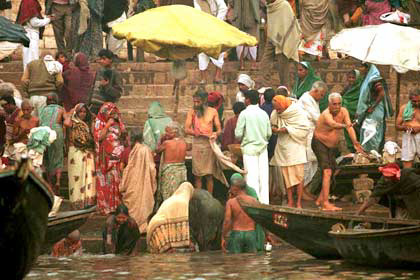SWEDISH SOUTH ASIAN STUDIES NETWORK
Sidsel Hansson, at the Dept of History of Religions, at Lund University:
 defended
her doctoral dissertation on 28 September, 2001
defended
her doctoral dissertation on 28 September, 2001
Faculty opponent: Lawrence Alan Babb, Prof at the Dept of Anthropology-Sociology and Asian Languages and Civilizations, Amherst College, Massachusetts, USA
Title and subtitle:
Not Just Any Water: Hinduism, Ecology and the Ganges Water Controversy
Abstract: Whether the Ganges river in Varanasi (India)
is pristinely pure or heavily polluted depends on by whom it qualities
are defined, the Brahmin religious specialists in the city or the science
oriented environmentalists.
While the controversy continues, some Hindu religious leaders are searching
for ways to adjust their respective traditions to the environmental paradigms,
an initiative that reflects a larger global religious trend. In this study
the environmental positions taken by Brahmin religious specialists in
the city are briefly outlined. Irrespective of their position with regard
to the new environmental agenda, the religious specialists are guided
by a common concern to preserve the ritual domains at the riverbanks in
the city.
The study mainly focuses on a ritual domain at the urban riverfront where local residents gather to bathe. Among these residents the question of the qualities of the Ganges is not so much a matter of taking up positions as trying to make sense of yet another troubling aspect of everyday life. In this setting the environmental problems at the Ganges is commonly perceived as a problem of local governance.
Firstly, everyday perceptions and practices at the riverside are outlined through a discussion of the role of purity, honour and gender in the structure of the ritual domain. Secondly, some key practices (the Ganges bath, purification) and perceptions (the qualities attributed to the Ganges) in this setting are discussed from the perspective of religious change. The examination shows that the structure of the ritual domain relies not only on the concept of purity, which in certain contexts is a rather flexible notion, but is also upheld by the more widely accepted definitions of honour and gender.
To the extent that the specific ritual domain that has been studied here can be seen as representative for other similar sites along the urban riverfront in Varanasi, the following observations can be made. The ritual domain that the Brahmin religious specialists search to preserve is challenged not only by those who take up a science-oriented environmental position, but also by everyday visitors at the riverbanks who want to redefine the site as a public space. Furthermore, its position is weakened by a tendency towards de-ritualisation among the young. The question of environmental awareness and religious change has been raised in the context of laymen’s perceptions and practices at the riverbanks. Change was examined by means of concepts from theories of the secularisation of religion. Age group was used as a time dimension.
The examination indicates that religious change is taking place. A common trait among young men at the site is that they tend to simplify their ritual acts, and readily incorporates the view that the Ganges is polluted, although their definitions of pollution may vary. With regard to other aspects such as value pluralism and privilege of interpretation, the tendencies among the young vary, and caste and education may be significant for these variations. As these two dimensions co-vary, it is difficult to determine which may be the most significant dimension. Education seems to be a significant dimension for environmental perceptions. The question of possible correspondences between environmental and religious perceptions has also been examined, but no clear tendency was found.
The dissertation is a monograph, published as Volume 13 in the series ”Lund Studies in African and Asian Religions”.
SASNET - Swedish South Asian Studies Network/Lund
University
Address: Scheelevägen 15 D, SE-223 70 Lund, Sweden
Phone: +46 46 222 73 40
Webmaster: Lars Eklund
Last updated
2010-12-14
